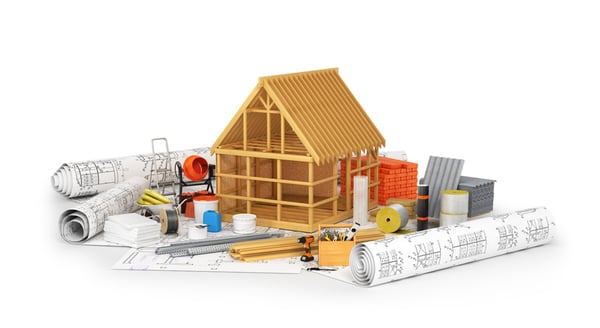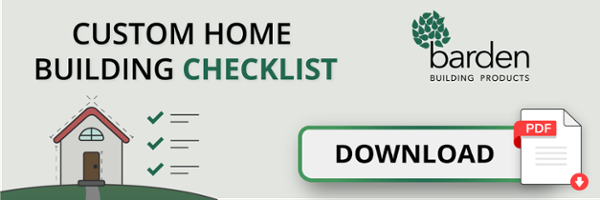The Barden Custom Home Building Process Step-by-Step

Though constructed faster than other types of houses, Barden custom panelizedhomes aren’t built overnight. What’s more, they don’t just happen on their own, either.
The Barden custom home building process – which is rooted in panelized construction – begins many months before building crewing arrive on site. It also involves the future homeowner working closely with an independent dealer and even construction crews and specialty contractors (depending on the homeowner’s level of involvement).
All told, a Barden home represents careful planning, thoughtful coordination, and open communication.
To help you understand exactly what building a Barden custom home looks like or manage your own project, we've broken down the process step-by-step.
In this custom home building checklist, we examine what you should expect or handle during key time periods in making your custom home a reality. We take you through each phase of the custom home building timeline, including:
Six months prior to building permit application
Four months prior to building permit application
Two months prior to building permit application
On submission of building permit application
When building permit is issued and during construction
When project is nearing completion and ready for final inspection
When project is completed and during the warranty phase
Timeline Icon Key
As you go through this checklist, you'll notice icons with each step of the process. Check out the table below of the icons you'll see and what they mean.
This icon represents Decision Making and Design/Build Matrix considerations. |
This icon represents Quality Control and personal aesthetic considerations. |
This icon represents Budget Estimating and Cost Analysis. |
This icon represents Green Living and Building philosophies and considerations. |
This icon represents Project Schedule and Timeline considerations. |
This icon represents Permits and their related procedures and considerations. |
This icon represents Build Site Development and Preparation. |
This icon represents Contract Documents and the requirements surrounding their use. |
This icon represents Drawings and their related build considerations. |
This icon represents Trade Contractors and things to consider when working with them. |
This icon represents your “Punch List” for planning and tracking information. |
This icon represents Suppliers and Purchasing considerations for materials and products. |
This icon represents Specifications to keep organized and under control. |
This icon represents Safety considerations for yourself and your contractors. |
Custom Home Building Process:
Six Months Prior to Building Permit Application
 1. Consider Your Capabilities and Define Your Anticipated Level of Involvement in the Project
1. Consider Your Capabilities and Define Your Anticipated Level of Involvement in the Project
Now is the time to understand and appreciate the difference between “office” and “field” management, and ascertain where your strengths and weaknesses may lie in terms of helping the project along.
Determine what professional services may be needed to supplement your work on the project, and begin to make a list of potential collaborators.
If any amount of management sounds uncomfortable, that's important to know! Make sure you vocalize that you want a turn-key home with no involvement.
 2. Begin an Initial Study of All Project Costs With Your Home Building Partner
2. Begin an Initial Study of All Project Costs With Your Home Building Partner
This is an exercise in project feasibility. Contact a construction lender to discuss the financing of your project, and determine whether you prefer to act as an Owner-Builder or hire a General Contractor. Be sure to pre-qualify for a loan while you are working with the lender.
Identify your cost range and requirements for your home. This should be a price range based on your conversations with your lender and a list of functions your home must be able to accommodate, NOT a square footage number and list of rooms and features.
 3. Create a Reasonable Project Timeline Goal for all Design-Build Events
3. Create a Reasonable Project Timeline Goal for all Design-Build Events
The goal of this is to help you distinguish when you would like your project to be completed, versus when it will actually be completed.
The latter should allow for ample time for the entire design-build process. Be sure to be realistic about your current commitments and how much time you’ll be able to allot to moving the project along.
 4. Before Purchasing a Lot, Make Sure That it’s Buildable for Your Project Needs
4. Before Purchasing a Lot, Make Sure That it’s Buildable for Your Project Needs
The main consideration is finding a lot where development is economically feasible; meaning the cost of the lot and development fit your budget, and a new home built in that location will be appraised to its full value.
It’s best to have a Barden Independent Dealer involved in this step to lend their experience in both of these areas.
Once that has been accomplished, make sure that the lot is able to meet city or county requirements for the issuance of a building permit. This includes having an official copy of your lot’s site map with tax parcel number and legal description.
Your Barden Independent Dealer should be able to determine whether or not the lot is buildable.
 5. Define How You Intend to Live and Characterize the Best Place in Which to do it
5. Define How You Intend to Live and Characterize the Best Place in Which to do it
Now that you have a lot, use the information determined in step 2 to begin visualizing what kind of home to build. This can be the most time-consuming step if you are not prepared!
This is why we make a list of required functions, but not features. Maybe you were set on a two-story home, but now that you have your lot, you realize that the second story would be exposed to your neighbors. Or, maybe the formal dining room you wanted in the back corner of your house is now impeding the best view from the places in your house where you will spend most of your time.
Putting all of these pieces together can’t be done properly until you understand your own needs and have a lot and budget ready to plot them out on.
Now is the time to begin to put these pieces together in your mind or on paper. Remember, you’re just visualizing at this stage. Don’t get too attached to anything determined at this point! There is still a long process ahead, stay open to change!
 6. Decide How You Intend to Record Information Related to Project Management
6. Decide How You Intend to Record Information Related to Project Management
If you’re someone who likes an old-school paper and pencil to keep track of information, that will work great! If you prefer computer software, that’s great too.
Prepare a system to keep track of ALL documents related to your project; permits, receipts, quotes, etc. This is unbelievably important to keep your project on schedule.
 7. Create a “Cardboard Box File” by Purchasing a 12”x16” Cardboard Banker’s Box
7. Create a “Cardboard Box File” by Purchasing a 12”x16” Cardboard Banker’s Box
Place 50, letter-size hanging files into the banker’s box, and then insert ⅓-cut file folders inside each of the hanging files. Label the tabs according to each phase of the building process.
Become accustomed to filing information as your project develops, and keeping things organized.
 8. Create a “Storyboard” on a Wall in a Designated Area of Your Home Planning Space
8. Create a “Storyboard” on a Wall in a Designated Area of Your Home Planning Space
Dedicate half of the board for exterior ideas, and the other half for interior ideas. Hang pictures, colors, swatches, material samples, and sketches on the wall and begin to visualize how they work together.
Google samples of custom home building storyboards online for inspiration of where to begin if you get stuck!
 9. Research Publications and Sources that Support a Building and Living Green Philosophy
9. Research Publications and Sources that Support a Building and Living Green Philosophy
It’s also a great idea to contact your State Department of Ecology and your County Solid Waste Disposal agencies to discover more information.
Additionally, see if there are any local green building homes on display to help inspire some elements of your build. If there aren’t any in your area, leverage digital tools such as YouTube, Pinterest, and Houzz for inspiration and education.
Understand that although “green” can be a buzzword, including some energy-efficient features in your home can be a very worthwhile investment and even potentially raise the value of your home!
 10. Determine Who Will be a Part of Your Building Team
10. Determine Who Will be a Part of Your Building Team
Asses your build situation and goals with your Barden Independent Dealer. If you’re planning on doing the work yourself, now is the time to determine if you have the time available and the expertise to complete the task at hand or to hire in other help. You may already have subcontractors you wish to use on the job.
Now is the time to consider their schedules and professionalism vs. subs that have proven themselves working with your Independent Dealer in the past.
Not sure where to start? Talk it over with your Independent Dealer.
| Resource: What's a Barden Independent Dealer? Find out here! |
Custom Home Building Process:
Four Months Prior to Building Permit Application
 1. Develop a Strategy for Achieving Your Overall Budgetary Objective
1. Develop a Strategy for Achieving Your Overall Budgetary Objective
Do a rough percentage budget estimate of both hard and soft costs to help determine project feasibility.
Ask a construction lender for an application packet, but wait before making and paying for a loan application. This will provide you a list of what’s officially required by the lender when it comes to apply for a construction loan.
 2. Produce a Draft Site Plan for Your Lot
2. Produce a Draft Site Plan for Your Lot
Ensure the plan follows the guidelines provided by the local building department that has jurisdiction over your site. If you’ve been following this timeline checklist, you should already have them on file!
The site plan usually includes:
- A legal survey
- Existing natural features
- Topography
- Utility locations
- House footprint
Don’t forget to indicate adjacent streets, access to site, tax parcel number, and legal description.
Make multiple copies of this! Ensure you retain ownership over the original copy.
 3. Sketch a Floor Plan Based on how You Intend to Live in Your New Home
3. Sketch a Floor Plan Based on how You Intend to Live in Your New Home
Be sure to move fluidly through several versions and revisions of this sketch, but don’t allow yourself to get too bogged down with precise details.
Provide a sketch to the Barden drafting team along with copious notes; the more our drafting team understands your needs and goals, the quicker they will be able to provide satisfactory modifications to your plans.
This means that you don’t just ask them to move a wall 2 feet, but explain why. The experienced team may find a better solution if they know the end goal!
 |
 4. Start to Think and Act Like a Project Manager by Creating a “Job Diary”
4. Start to Think and Act Like a Project Manager by Creating a “Job Diary”
This job diary should include: a business card index, weekly appointment book, incoming / outgoing phone message register, memo forms, and anything else that is relevant to the contact organization aspect of your project.
Some people opt to keep this organized digitally on their smartphones and laptops, and that’s great too! The key is contact organization that is intuitive and clear, so you have all the info you need when the time comes to reach out to someone.
 5. Elaborate the “Cardboard Box Files” With a Contractor and Product Information.
5. Elaborate the “Cardboard Box Files” With a Contractor and Product Information.
When you come across trade or product information that is useful, file it into the box as a possibility for future use.
Be sure to also file any subcontractor information you come across while planning. Did your friend recommend an excellent tile worker? Be sure to file this in the box for future contact, and note the friend who recommended the subcontractor. Soon, you will have a network of people, and products, formed.
 6. Expand Your Storyboard With Exterior and Interior Colors, Patterns, and Textures
6. Expand Your Storyboard With Exterior and Interior Colors, Patterns, and Textures
Start by grouping combinations that seem to go together so you can compare and contrast one grouping to another until you find what speaks to your heart the most. DO NOT get this confused with designing your floor plan. The floor plan should be set based on your needs and then decorated accordingly based on inspiration gained from sites like Pinterest, not designed around features and designs found there!! We can’t stress this enough.
This is a finishing step; weeks and months can be lost trying to determine finishes and decor side by side with designing a floor plan.
 7. Call Your Building Department to Request a “Permit Submittal Packet” for Residential New Construction
7. Call Your Building Department to Request a “Permit Submittal Packet” for Residential New Construction
Additionally, ask about the possibility of a “pre-application meeting” at the local permit-granting agency.
Inquire whether any special conditions exist for your building site such as wetlands, shoreline, or flood plain review to avoid surprises down the line.
These steps may be excessive but they ensure a perfectly planned project.
 8. Research What Supplier and Manufacturers are Available Locally
8. Research What Supplier and Manufacturers are Available Locally
Do this for insulation, plumbing, electrical/lighting, HVAC, and flooring. Barden has you covered on the rest!
If local suppliers and manufacturers exist in your region, inquire about whether they sell directly to the general public for residential purposes.
Ask suppliers, when possible, for a list of preferred contractors who they would recommend install their products. This can also help you build your network of trusted contacts.
Custom home Building Process:
Two Months Prior to Building Permit Application
 1. Involve Construction Professionals of Your Project Team in the Decision Making Process
1. Involve Construction Professionals of Your Project Team in the Decision Making Process
Meet with your plumber, electrician, and HVAC installer along with your Independent Dealer. These people will not only be installing these features, but designing them in your home as well.
Make sure to speak with them and make these design decisions early on for a more accurate quote and better planning going forward.
 2. Select a Fiscal Plan of Action Based on a Review of Hard and Soft Costs
2. Select a Fiscal Plan of Action Based on a Review of Hard and Soft Costs
Combine all of your outlined hard and soft costs into a complete cost analysis.
This cost analysis should be expanded to include itemized costs and prices. However, keep in mind that this document is subject to change, especially as the insight of experts begins to weigh more heavily into your project.
At this point, however, you should have a clear cost range and understand spend considerations moving forward.
 3. Discuss Project Requirements with Designers, Contractors, and Suppliers.
3. Discuss Project Requirements with Designers, Contractors, and Suppliers.
Continue to update your “Activity Flow Chart” with information that you glean from speaking with key project team members.
Make sure to be noting areas of activity independence -- or, where your team will be working independently of your control, where you are trusting them to make decisions. Discuss, clarify, and gain a comfort level with this.
 4. Make a Site Master Plan That Goes Beyond what is Required for Permit Application
4. Make a Site Master Plan That Goes Beyond what is Required for Permit Application
Take into consideration your region’s geological, biological, and meteorological conditions as you enhance the basic site plan that has been prepared for submission to the Building Department.
Envision how you intend to use the outdoor space once the home is completed so your home is oriented to the sun, off-site features, native plans, lay of the land, and neighboring community.
Begin to look at your space as a home.
 5. Formalize the Floor Plan by Consulting a Design Professional
5. Formalize the Floor Plan by Consulting a Design Professional
After discussing plans for your HVAC, plumbing, and electrical and finalizing details on your floor plan, request final plans from Barden.
Full structural plans will be presented for your final review.
 6. Concentrate on Using the “Job Diary” Daily
6. Concentrate on Using the “Job Diary” Daily
Now is the time to get in the habit of running an efficient and reliable construction office. We recommend color coding whenever possible to keep project-related tasks separate from personal tasks and appointments, as well as your professional ones.
Don’t forget to log and take notes on any calls that happen so you create a clear picture of communication for your project.
 7. Continue to Use the “Cardboard Box Files” as a Means to Organize
7. Continue to Use the “Cardboard Box Files” as a Means to Organize
Get comfortable and familiar with the process of progressive approximation so you feel relaxed about a gradual refinement of product and material choices.
Now is the time to be collaborating with the professionals on your product team, as well as potential trade contractors and suppliers.
 8. Turn a Critical Eye to the Combinations on Your Storyboard
8. Turn a Critical Eye to the Combinations on Your Storyboard
Eliminate colors, patterns, and textures that you know will not be considered for your project. Be mindful of budget while making these cuts. Even if something looks aesthetically pleasing for your project, is it realistic?
Be sure to mark samples that stay with manufacturer product information, including distributor and contact person.
 9. Collect All Documentation Required for Building Permit Application
9. Collect All Documentation Required for Building Permit Application
Make sure to make duplicate copies to share with the professionals you are collaborating with on your project team.
In addition to your building permit, additional permits may be required for septic, electrical, plumbing, gas, and HVAC inspections. Be sure that trade contractors are adequately taking responsibility for securing the permits that govern their work.
 10. Prepare Your Conditions Document Prior to Meeting With Contractors
10. Prepare Your Conditions Document Prior to Meeting With Contractors
Make sure that you understand that subcontractors’ terms are negotiable. Read their agreements and negotiate terms as necessary to ensure your project is completed on time.
Remember to be reasonable! If you become too demanding, they also have the right to refuse to work with you! This is a very fine line.
 11. Select Products and Materials to be Used in Your Home
11. Select Products and Materials to be Used in Your Home
Once a decision is made on what product/material is right for your project, request details from your dealer on different models, color choices, pricing, and warranties.
Need to Take a Break?Download a copy of our Custom Home Building Checklist right now and return to it at your leisure! |
Custom Home Building Process:
On Submission of Building Permit Application
 1. Hold Your Team Accountable for Their Decisions
1. Hold Your Team Accountable for Their Decisions
It’s important to stay involved with your team of construction professionals every step of the way. Keep the doors of communication open, and don’t just assume that your team is making the right decisions on your behalf.
Lean on professionals to act as consultants when issues come up that need attending to.
 2. Ensure All Products and Services are Line Items on Your Cost Analysis
2. Ensure All Products and Services are Line Items on Your Cost Analysis
The itemized list should represent all expenditures that are defined on your drawings and specifications. If you need additional assistance ensuring everything is included, your construction lender is a great resource.
As you receive proposals from contractors, evaluate costs by referring to a larger database or expert on your team.
 3. Establish a Project Schedule Using a Bar Chart
3. Establish a Project Schedule Using a Bar Chart
This chart will indicate major construction activities plotted on a weekly time scale. In previous months, you’ve established an activity flow chart which will be a great resource to lean on to determine the sequence and communication timeline for the chart.
Remember: Your project may require less or more time depending on your scope of work to be performed, and factors including weather. The chart can be customized and tweaked as you move forward accordingly.
Communicate openly with contractors and team members to understand what is realistic from their standpoint for time requirements and deadlines and don’t be afraid to hold them accountable.
 4. Reproduce 8 copies of Your Complete Set of Drawings.
4. Reproduce 8 copies of Your Complete Set of Drawings.
It’s standard for 2 copies to accompany your permit application, while the other 6 are passed out among contractors and suppliers for their proposals.
If any changes are made to the drawings by the Building Department, it’s crucial to ensure that all copies are edited to reflect the changes. Because changes are common, ask the Building Department for an approximate timeline for how long before the drawings are returned to you -- so you can coordinate the commencement of site development accordingly.
 5. Produce a “Communication Sheet” for Your Project
5. Produce a “Communication Sheet” for Your Project
By creating a communication sheet, you’ll come close to eliminating misunderstandings between you and members of your project team.
This communication sheet should include:
- A vicinity map
- Directions to the site
- A good phone number (and backup numbers) to reach you at
- How to contact the professionals on your construction team
- Any special reminders that are pertinent such as email address or times when you can’t be reached
 6. Increase What You Know About Products and Materials Required for Your Project by Adding to Your “Cardboard Box Files”
6. Increase What You Know About Products and Materials Required for Your Project by Adding to Your “Cardboard Box Files”
Utilize these files as a storehouse for manufacturer specifications, installation instructions, material safety data sheets, guarantees, and warranties for each phase of work.
Add extra categories if needed to your filing system.
 7. Select a Combination of Colors, Patterns, and Textures for Interior and Exterior Treatment
7. Select a Combination of Colors, Patterns, and Textures for Interior and Exterior Treatment
Your storyboard should begin to appear purposeful and artful. Each item should have a manufacturer-specific name and/ or number.
It’s crucial that you indicate this name/ number when you purchase the products and materials either from the supplier or through the contractor.
This is VERY difficult to do ahead of time, but doing so reduces the chance of being delayed by a supply shortage or having a product shipped from far away. Last-minute orders and decisions can ruin timelines!
 8. Submit a Complete Building Permit Application
8. Submit a Complete Building Permit Application
It is likely that you will have to pay an initial plan examination fee when you apply, and another final fee when you pick up the finalized permit.
Your drawings will be closely scrutinized by experts, so be prepared to supply additional information if necessary, and willing to make corrections as needed. This is why it is crucial to remain in close communication with members of your building team.
Remember, you’re allowed to check the progress of the application with the Building Department, as well as inquire about approximated approval timeline.
 9. Review Contractors Boilerplate Forms Before Showing Them Your Conditions Document.
9. Review Contractors Boilerplate Forms Before Showing Them Your Conditions Document.
The difference between what’s important to you and what’s important to them should become apparent upon review of their standard template.
Once you’ve decided on your general or specialty contractors with whom you expect to be doing business, arrange a second meeting to make a copy of your conditions available. At this point, ask them for their review and commentary before anything is signed.
If you’re comfortable with a person’s reputation then a handshake will sometimes suffice, but we advise against doing so if the contract price exceeds $1,000. It’s important to have written conditions to ensure the job is being completed to your satisfaction, and you can enforce the terms of your agreement.
 10. Continue to Negotiate with Additional Suppliers, Contractors, and Businesses as Needed
10. Continue to Negotiate with Additional Suppliers, Contractors, and Businesses as Needed
Remember: How quickly these individuals respond to you is a fantastic gauge of their interest level in your project.
Since your drawings and specifications are substantially complete at this phase, you are able to accurately reference these documents during conversations with potential additional team members.
 11. Double Check Safety Concerns Involving Contractors and Suppliers
11. Double Check Safety Concerns Involving Contractors and Suppliers
During negotiations with contractors, ask if the field supervisor is first-aid certified and requires crews to have a first-aid kit on site. Ask each contractor to provide proof of insurance coverage when they offer their proposal.
Suppliers delivering items to your site are less at risk, but it never hurts to ensure that their employees are covered by insurance as well.
Custom Home Building ProcesS: When Building Permit is Issued and During Construction
 1. Engage the Services of Construction Professionals Only on Those Matters That Continue to Demand Their Attention
1. Engage the Services of Construction Professionals Only on Those Matters That Continue to Demand Their Attention
Make sure that you are at the helm when it comes to handling routine decisions and actions. Only emergencies and major plan deviations should be reported to the expert professionals on your team.
KNOW WHO TO CALL FOR WHAT.
Nothing is worse for communication than a customer contacting someone about a task unrelated to theirs. The customer feels that they’ve informed someone involved in the project, but in reality, their wishes haven’t been conveyed at all.
 2. Utilize a “Check Register and Job Cost Journal” to Record Expenditures
2. Utilize a “Check Register and Job Cost Journal” to Record Expenditures
Dedicate this register exclusively for construction expenses so that there is an easy audit trail for your project.
If you’re not sure where to begin or what to include, consult an accountant who is familiar with construction cost accounting. Also, establish monthly inspections by your lender’s representative to determine what work has been performed so progress payments can be issued through you, to the contractor.
Any costs that come in under budget should be rolled over to the next line item. DO NOT spend additional cash until the end, there are ALWAYS unforeseen costs.
You’ll have no problem finding ways to spend any leftover cash at the end of the project, trust us.
 3. Anticipate Construction Activities and Key Events By Referring to Your Bar Chart and Activity Flow Chart
3. Anticipate Construction Activities and Key Events By Referring to Your Bar Chart and Activity Flow Chart
These sources of information will prompt you to think weeks ahead when ordering products and materials from suppliers, as well as scheduling any specialty contractors’ arrivals on site.
Additionally, these charts can help you understand what’s being accomplished by the general contractor (if applicable).
- Be sure to make note of any issues that impede your schedule, such as:
- Site logistical changes
- Weather conditions
- Trade contractor availability
- Material delivery
 4. Set Up Site Layout
4. Set Up Site Layout
Install the temporary electric and water service, as well as a portable toilet on site if necessary.
Determine where to store materials and designate a work area. Establish building dimensions and elevations for landscaping. Protect any shrubs and trees that you intend to use later as a part of the landscape.
Important: Do not disturb any area where a septic tank/field would be installed.
 5. Retain the Official “Approved” Set of Drawings From the Building Department
5. Retain the Official “Approved” Set of Drawings From the Building Department
Note any corrections or changes that were made on your original drawings that may affect proposals or material orders.
Any work that is done that is not represented on the drawings will need to be illustrated on an alternate document and kept for future reference. These will be what is known as your “As-Built” drawings and will serve as the official representation of your final home.
Unsure if Building a Custom Home is the Right Move?Take our FREE assessment to make the best decision for you and your family: |
 6. Maintain an Accurate Diary of Construction-Related Activities
6. Maintain an Accurate Diary of Construction-Related Activities
The communication sheet will continue to help designers, contractors, and suppliers with logistics and timeline questions. Unless you agreed on a “turn-key” home, never let your answer be “I don’t know”!
It’s important to also set weekly deadlines for incomplete tasks or repair damaged products. Be persistent with those who need to correct their work, and do not be afraid to withhold payment for incomplete or deficient work.
Because you have created a standard way to document everything, you have the power in ensuring each job is done correctly.
 7. Perform Quality Control Inspections Daily and Weekly
7. Perform Quality Control Inspections Daily and Weekly
Check the work that is being performed against your drawing and specification documents, as well as your agreed-upon conditions with contractors and suppliers.
Use your cardboard box files as needed for confirmation of the manufacturer’s guidelines for product installation.
 8. Confirm Product / Material Choices From the Storyboard
8. Confirm Product / Material Choices From the Storyboard
Double-check specific names and numbers to be sure of the correct color, pattern, or texture.
 9. Place Bins On Site for Refuse, Recycle, and Reuse
9. Place Bins On Site for Refuse, Recycle, and Reuse
Keep the refuse bins separate from the other areas because debris can contaminate any of your recycle and reuse materials.
Each trade contractor and supplier should be responsible for recycling efforts, but, if necessary, coordinate pickups at your site with a recycling service.
 10. Check With the Building Department to Ascertain Mandatory Inspections
10. Check With the Building Department to Ascertain Mandatory Inspections
The agency that has jurisdiction in your locality may have standard procedures for arranging inspections, and the critical events that require inspections.
Other permits requested by trade contractors will require additional inspections -- and the contractor requesting the permit should coordinate the inspection. Keep possession of any correction notices, as well as the signed final permits.
 11. Be Certain That All Requirements of an Enforceable Contract are Included in Your Conditions Document
11. Be Certain That All Requirements of an Enforceable Contract are Included in Your Conditions Document
Your approved drawings and written specifications should be referenced in your agreement, and conditions governing performance must be clearly reinforced.
 12. Sign “Agreement” with Contractors
12. Sign “Agreement” with Contractors
After reviewing the project’s requirements, qualifying contractors, and negotiating conditions -- enter into the “agreement” on the terms of your relationship.
Politely reiterate your concern to maintain schedule, budget, and quality of work. It is your responsibility to keep contractors informed of your expectations.
 13. Issue an Order for Purchase of Goods
13. Issue an Order for Purchase of Goods
Barden will order all materials listed on your order form in the correct quantities according to your plans For other materials, coordinate directly with the Specialty Contractor or supplier.
Schedule delivery when required, and be on-site to conduct quality control inspections.
Remember: Make payments only after completely satisfied with products/materials.
It is very common for items like kitchen cabinets to be damaged during shipping. Barden will handle the logistics in this case, but will only do so after we are informed of the issue. This can be done much more quickly if you inform us as soon as possible!
![]() 14. Keep an Eye on Safety and Site Conditions
14. Keep an Eye on Safety and Site Conditions
If your contractors are not wearing proper protective gear or operating in any unsafe manner, hold them accountable!
Direct your attention to the most common site hazards, but your daily observations are the most reliable means to protect people and property.
Custom Home Building Process: When Project is Nearing Completion and Ready for Final Inspection
 1. Send Thank You Notes to Construction Professionals of Your Project Team
1. Send Thank You Notes to Construction Professionals of Your Project Team
Request a copy of any document that you may need from their files regarding your job. Get their advice for any items that may be necessary to include on your Punch List.
 2. Use the Construction Cost Breakdown to Control Expenditures up to the Final Day of Construction
2. Use the Construction Cost Breakdown to Control Expenditures up to the Final Day of Construction
By comparing budget estimate and bid proposals to actual payments and extra costs, you force yourself to justify any change from your original fiscal plan of action.
Your "Check Register/Job Cost Journal" that you've used to write checks and categorize expenses will be a ready reference if there's a need to refer back to construction expenses.
Your construction lender will keep you focused on your payment schedule.
 3. Prior to Project Completion, Contact a Moving Service
3. Prior to Project Completion, Contact a Moving Service
Schedule transportation of your existing furniture and furnishings to your new home. Any newly purchased items should be stored at the distributor's warehouse so arrange delivery of these items at the same time.
 4. Install Landscape and Horticulture Features
4. Install Landscape and Horticulture Features
As you eliminate the need for temporary services on site, the area surrounding the building will cease to be a construction site and begin its transformation into your yard.
Your site master plan provides purpose and direction for landscape activities so base your installation on this design.
Create “As-Built” drawings for your site, depicting the actual layout of site conditions, should there be any changes from the original site plan. Better yet, snap a few pictures on your phone.
 5. Collect all Copies of Drawings from Contractors and Suppliers
5. Collect all Copies of Drawings from Contractors and Suppliers
Often, contractors will write notes and sketch on the margins of these field copies, and by retaining field copies there's a source for future reference to their notes and sketches.
Also, the "As-Built” drawings provide supplemental information for those details not represented in the drawings.
 6. Organize a Punch List and Ensure All Items are Complete
6. Organize a Punch List and Ensure All Items are Complete
Remain constantly vigilant toward trade contractors and suppliers completing those details that are incomplete or deficient.
Identify what's required to finalize work on your project, contact the person responsible for work to be accomplished, and set deadlines for the work to be completed.
 7. Regard Your Cardboard Box Files
7. Regard Your Cardboard Box Files
These files have proven to be a ready reference for quality control activities, but as a repository for all project information, the box becomes a valuable resource for yourself or the next homeowner.
Needless to say, your Cardboard Box Files are impossible to replace!
 8. Take a Picture of Your Design-Build Collage in its Final Form
8. Take a Picture of Your Design-Build Collage in its Final Form
Clear the wall of the storyboard. Color, pattern, or texture samples should be labeled with the manufacturer's name and identification number for future reference.
Double-check product installation to verify correct models/colors have been utilized.
 9. Hire a Professional Cleaning Crew to Polish Your New Home
9. Hire a Professional Cleaning Crew to Polish Your New Home
Take the "Building Green" philosophy and translate it into a "Living Green" program. Incorporate vegetable, flower, and herb gardens into your landscape design, and reduce kitchen waste by using a compost bin in your garden area.
 10. Call for a Final Inspection From the Building Department
10. Call for a Final Inspection From the Building Department
Resolve any last-minute problems in a diplomatic, rational manner.
Be sure that the trade contractor responsible for the error or omission is the one who makes the necessary correction.
 11. Consolidate Your Contract Documents
11. Consolidate Your Contract Documents
With your project at completion, dedicate one file for all legal paperwork. In this way your "Cardboard Box Files" contain primarily trade contractor, supplier, and manufacturer information.
A single legal file exclusively holds all contract documentation.
 12. Send Thank You Notes to Your Contractors
12. Send Thank You Notes to Your Contractors
Request a copy of any document that you may need from their files regarding your project. If you withheld money from the contract price for "callbacks" write a check for work completed & include it with the note.
 13. Send Thank You Notes to Suppliers
13. Send Thank You Notes to Suppliers
Be sure you have a copy of all manufacturers' parts lists and record customer service phone numbers. Operate all products as soon as possible to verify that the product works properly.
 14. Dispose of Hazardous Waste Through Your County Reclamation Services
14. Dispose of Hazardous Waste Through Your County Reclamation Services
Contact your insurance agent requesting course of construction coverage be terminated and commence homeowner's coverage.
Custom Home Building Process: When The Project is Completed and During the Warranty Phase
 1. Be Sure All Documents are Stored in the "Cardboard Box Files"
1. Be Sure All Documents are Stored in the "Cardboard Box Files"
Many homeowners opt to write a memoir of your project experience, reflecting on the Design-Build endeavor.
Whether prose or poetry, your memoir should combine aesthetic and technical musings.
![]() 2. Close Bank Account Dedicated to Your Project
2. Close Bank Account Dedicated to Your Project
Store "Construction Cost Breakdown" and "Check Register/Job Cost Journal" in the "Cardboard Box Files."
![]() 3. Create a Maintenance Schedule for Products in Your New Home Requiring Future Service
3. Create a Maintenance Schedule for Products in Your New Home Requiring Future Service
Store "Activity Flow Chart" and "Bar Chart" in the "Cardboard Box Files".
 4. Store "Official Site Plan, Site Master Plan, Site Landscape, and As-Built Drawings" in the "Cardboard Box Files”
4. Store "Official Site Plan, Site Master Plan, Site Landscape, and As-Built Drawings" in the "Cardboard Box Files”
This way, if any items need future referencing, you have them in one easy place.
 5. Make Certain All Field Notes are Collected From Contractors and Suppliers for Future Reference
5. Make Certain All Field Notes are Collected From Contractors and Suppliers for Future Reference
Store "Approved Drawings, Field Drawings, and As-Built Drawings” in the "Cardboard Box Files".
 6. Be Certain the Business Card Index, Weekly Appointment Book, Incoming/Outgoing Message Register are Consolidated and Complete
6. Be Certain the Business Card Index, Weekly Appointment Book, Incoming/Outgoing Message Register are Consolidated and Complete
Store all items comprising the "Job Diary" in the "Cardboard Box Files".
 7. Share Your Information Base for Your Project With a Friend or Neighbor Doing a Home Building or Remodeling Project
7. Share Your Information Base for Your Project With a Friend or Neighbor Doing a Home Building or Remodeling Project
Don’t give-away original documents, but make copies for others.
 8. Store "Design/Build Collage" in the "Cardboard Box Files"
8. Store "Design/Build Collage" in the "Cardboard Box Files"
Utilize the storyboard technique on other projects.
 9. Place Your “Building/Living Green” Notes and Contacts Into a Separate File to be Stored in your “Cardboard Box Files”
9. Place Your “Building/Living Green” Notes and Contacts Into a Separate File to be Stored in your “Cardboard Box Files”
Join a neighborhood organization dedicated to these principles, and attend the annual Earth Day celebration in your community.
 10. Keep Signed Copies of All Permits in a Single File in your “Cardboard Box Files”
10. Keep Signed Copies of All Permits in a Single File in your “Cardboard Box Files”
If a newsletter is produced or continuing education classes is offered by your local Building Department, attend them to keep on top of current regulations governing your site.
 11. Be Certain That the Time Period Imposed by Your State for “Warranty of Habitability” Remains in Full Force
11. Be Certain That the Time Period Imposed by Your State for “Warranty of Habitability” Remains in Full Force
Don’t limit your consumer rights by ever agreeing to a lesser period of warranty. Contact your State’s Attorney General’s Office of Consumer Affairs, inquiring about your warranty rights.
 12. Store All Contractor Documents and Dotes in the "Cardboard Box Files"
12. Store All Contractor Documents and Dotes in the "Cardboard Box Files"
Let Contractors know of your willingness to be a reference for them, and don’t hesitate to share your referral list with friends.
 13. Complete and Mail Registration Cards that Accompany Products and Appliances to the Manufacturer
13. Complete and Mail Registration Cards that Accompany Products and Appliances to the Manufacturer
Keep all literature inside shipping containers and all warranties in your "Cardboard Box Files.”
 14. Keep Your "Safety File" in the "Cardboard Box Files"
14. Keep Your "Safety File" in the "Cardboard Box Files"
Be sure your “Material Safety Data Sheets” are placed in the same file for future reference.
The Custom HOme Building Process With BArden: How we Help
As you can see from this lengthy list, there are an unbelievable amount of variables associated with off-site building and the custom home building process. For this reason, many builders won’t touch an off-site custom build or offer a reasonable price.
With more than 70 years in the custom home industry, we’ve developed refined systems that streamline the entire custom home building process.
We’re able to optimize custom home construction and control costs by keeping much of what goes into building a custom home in-house as possible and acting as a building materials supplier.
All future Barden homeowners work directly with a Barden Independent Dealer, a single point of contact who guides a client through realizing their dream home and coordinates the project. Our design and drafting team creates and refines your custom home plans. Every finalized floor plan includes pinpoint-accurate measurements, material take-offs, and estimates. Once approved, your plans are sent over to North American Truss, our manufacturing division that makes all the structural and framing components of a Barden home (wall panels, roof trusses, floor trusses).
Whether it’s your independent dealer, a general contractor, or yourself, our panelized home building process – which features our Fast Track Framing System – makes initial construction efficient. A Barden home can be made weathertight in under 10 days. And as the house is built, components are delivered exactly when they’re needed.
While all custom home projects are impacted by a wide variety of factprs, the Barden panelized construction method heads off many potential delays while streamlining the entire home building experience from the beginning. With more control over the process of building a custom home, you’ll worry less about any setbacks pushing your project off your schedule.
Take This Guide With You!
We'd be happy to send you a copy immediately. Just click the image below to get started!




